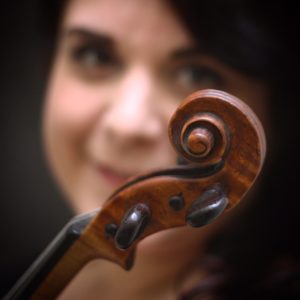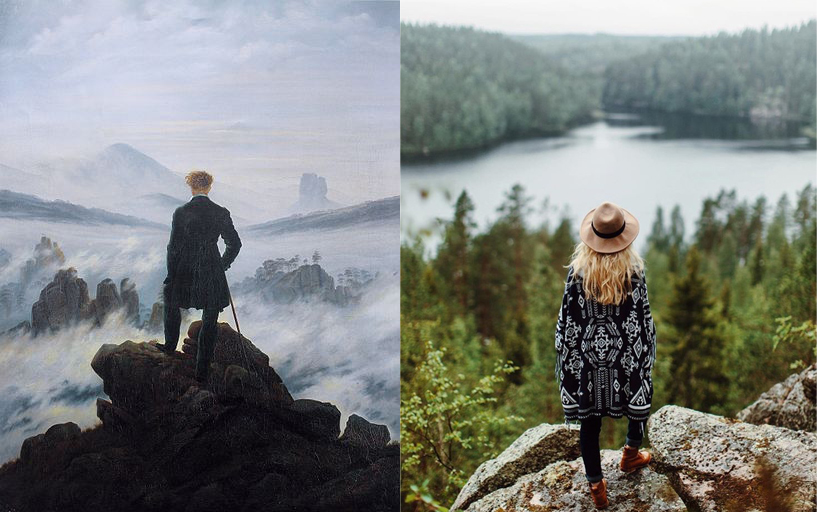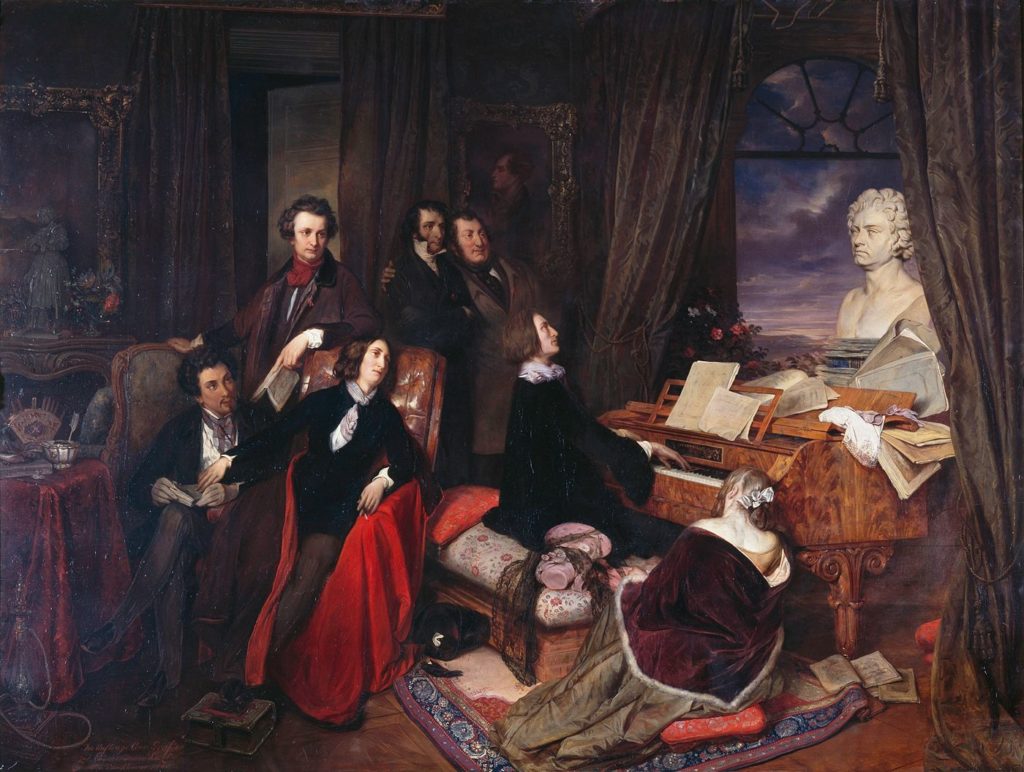ABOUT

“Ich komme vom Gebirge her,
Es dampft das Tal, es braust das Meer,
Ich wandle still, bin wenig froh,
Der Wanderer, 1821- Georg Philipp Schmidt von Lübeck
I am Olivia Steindler, a violinist and Italian blogger who has been living in Paris for more than fourteen years. I am a Romantic and passionate about this revolutionary movement, which has been transforming Europe for almost 200 years. It all began with the little known music of Paganini, my first challenge until the day I understood that to be a Romantic was a true act of rebellion!
Through the idea ‘I am a Romantic’, I explore the romantic repertoire, in particular the one dedicated to violin. I try to understand the movement, it’s influences, the great personalities of its time, and the historical key moments, in order to reunite them all together in one unique “red threat” like a kind of guide.
During my tours and concerts, I also meet the world’s greatest artists and share their vision through their expertise. Singers, conductors, pianists, violinists … all began their discovery of this music by means of their instruments and today are sharing their experiences through my blog.
The views and experiences of these artists are an invaluable treasure. They have explored this universe through their sensitivity, their curiosity and, above all, their courage. Each artist brings a unique interpretation to the works he plays; each takes an enormous risk by laying bare her vision through her interpretation.
Music is certainly the most international language, but today, more and more people don’t “dare” to enter concert halls: complex musical choices, staggering prices, full venues, social and vestimentary codes… so many reasons which in the end holds the audience up….
However the artists ask for nothing else then the possibility to express themselves, their thoughts are clear and accessible. They know the work they are interpreting, and can tell us with simplicity their vision in order to allow us to better understand their approach and this way get into the wonderful world of music.
As a violinist, I have the habit to be on both sides: on stage, after studying a work, alone or with other artists. Or in the hall, as part of the audience.
I am part of these people who can be the missing piece between these two aspects.
If you would like to discover a bit more about my own journey, I would like to resume it here in some keywords:
I have studied with: G.Skorupa (pupil of Irena Uminska), Valery Gradow (pupil of D.Oistrakh and L.Kogan), Grigorij Žislin, Franco Gulli, Yehudi Menuhin, Ivry Gitlis, Pierre Amoyal, Gérard Poulet and Salvatore Accardo…
In these places: Akademie für Tonkunst in Mannheim (Juniorenklasse), Accademia Walter Stauffer in Crémone, a very short stop at the Conservatoire de Lausanne
Obtaining following degrees: Abschlussdiplom Jugend Akademie DarmstadtJuniorenabschluss, Mannheim. Premier Prix et médaille d’or en violon et musique de chambre, special mention for baroque violin at Conservatoire de Strasbourg. Diploma di Perfezionamenento, Accademia Walter Stauffer. Diploma di violino “10 cum Laude” at Conservatorio “Giuseppe Verdi” Milan. at Ecole Normale de Musique de Paris.
I won: three times in a row the bi-annual National German Competition “Jugend Musiziert” (1988, 1990, 1992), and the “Palma d’Oro” (San Remo 1996),
I was laureate: 1st prize, three times at the National German Competition “Jugend Musiziert” (1988, 1990, 1992), and the “Palma d’Oro” (San Remo 1996),
I recorded: in June 2004 for the specialized magazine “CLASSICA”, which offers me to publish my recording of Baroque Italian Sonatas, of which I realized myself the transcription from the facsimile editions
An absolutely ugly recording, with Baroque Music and Gérard Poulet. It has been published without my consent. I will not tell the name of this shame!
My speciality is: playing all 24 Capricci by Paganini in one concert. I did this a few times: in Genoa when there still was the Museum >, than in Switzerland, in Germany, then on both tours in Asia,
And my other favorite is a Violin-Piano Duo with the young italian pianist Ugo Mahieux. Of course our speciality is the romantic repertoire
I have been thinking a long time about what could move me to write all this down, and what attracts me in particular to Romanticism. Romanticism is by no means an outmoded point of view. It is ever present and in a state of perpetual transformation.
Do you never feel the need to question the meaning of life? You’re always seeking answers and reassurance, yet you sense that this feeling of discomfort is leading you towards something greater, that this feeling of unease may be the source of a spontaneous and pure expression.

Caspar David Friedrich’s Wanderer above the Sea of Fog (1818) Currently at the Hamburg Kunsthalle Anastasia Glebova “Hiking in Repovesi National Park Finland” blog: Near the Lighthouse
One finds uncanny similarities between the symbolism of Romanticism and that of today. Only the props have changed. In the diptych immediately below, I have included two images: a painting and a photograph, both illustrating the identical situation, realized two centuries apart ….
And so, I invite you to take a brief journey into history with me. The following article excerpts are from Wikipedia, the only source that references Romanticism throughout all of Europe. You must forgive me, if I have not created an original narrative on the history of Romanticism. I found these articles (wikipedia) to be very pertinent and have only added or omitted a few words here and there:
Sturm und Drang (“tempest and passion”) was a German movement, at once political and literary, from the second half of the 18th century. It corresponds to a radical phase during the long period of the ‘Enlightenment’. The name of the movement is taken directly from a play by Friedrich Maximilian Klinger. It was written in 1776 and influenced by German nationalism, whose goal it was to turn the movement into a rebellion of feeling, of inwardness, as opposed to what was considered the abstract superficiality of the Enlightenment. Quite the opposite, it appealed to the cult of feeling and the grand myth of nature as expressed by Jean-Jacques Rousseau in the middle of the 18th century.
Sturm und Drang thus celebrates the irrepressible force of feeling and the cult of individuality, both considered necessary preludes to all creative activity. This movement led directly to what we more recently know under the name of ‘Romanticism’.
One of the more innovative ideas of this movement was the concept of the artistic genius, irrational and creative. He was no longer disciplined by reason, as in the Enlightenment, but moved by an inner freedom capable of casting off the shackles of codes and conventions, instead drawing on the subjective and listening for divine inspiration, for the promptings of intuition and of the passions. Such is the sketch of the rebellious man, of a superhuman who measured himself against God—in music, for example, where his irrepressible, unconquerable virtuosity would invite the artist to surpass himself to approach the ‘Divine’.
And so was born above all a new concept of art, understood as an absolute freedom of creation that refused to acknowledge restraints imposed by the rules of tradition and that claimed the right of the individual imagination to express itself in accordance with its own language.
The earliest form of Romanticism, called Frühromantik, or Early Romanticism, came about in Jena, Germany. The circle of Romantics in Jena was very cosmopolitan. It included such figures as Novalis, Ludwig Tieck, and Friedrich Schlegel, all of whom were closely aligned with the ideas of Fichte. It was they who formulated the doctrine of Romanticism and political Romanticism.
After 1804, German Romanticism took a new direction: it became the Hochromantik, or High Romanticism, of the Heidelberg Romantic school, with such names as Joseph von Eichendorff; the Grimm brothers, Jacob and Wilhelm; Achim von Arnim; and Clemens Brentano [whom I discovered by way of the correspondence of his sister Bettina Brentano – the future wife of Achim von Arnim – with both Goethe and Beethoven.]
Before this time, the pre-Romantic movement had been developing in Great Britain In the 1760s. Among the pre-Romantics were the Graveyard Poets, who included Thomas Gray, author of Elegy Written in a Country Churchyard, and Robert Blair, author of The Grave.(wikipedia). In 1764, Horace Walpole created a new genre with his novel The Castle of Otranto. This was the Gothic novel, a new form that was later taken up by Ann Radcliffe. These romans noirs, or ‘black novels’, exalt the taste for the morbid, terrifying, and mysterious as much as the disturbing eeriness of medieval ruins. Lord Byron achieved sudden fame with his narrative poem Childe Harold’s Pilgrimage, published around 1813. The protagonist, who drags his disenchanted melancholy all over Europe, became the model for the Byronic hero. Byron’s scandalous life and his death in Missolonghi in 1824, while fighting for the cause of Greek independence, raised his persona to the level of myth.
Meanwhile, in France, Romanticism took the form of a reaction against the national literature. English and German literature had been only momentarily enslaved by the discipline of classicism under the prevailing influence of the ‘Grand Siècle’; and what was properly known as Romanticism in Britain and Germany was the literary period in which the northern genius, regaining an awareness of its own self, repudiated the imitation of the French. By contrast, in France, land of a Greco-Latin culture and tradition, the literary style had been classical since the Renaissance. The name ‘romantiques’ had referred to those writers who at the beginning of the 19th century had freed themselves from the rules of thought, as opposed to the classicism and realism of the philosophers of the 18th century.
Nor was Italy to be outdone during this time. Italian Romanticism was closely associated with the Risorgimiento, the progressive unification of Italy that began at the end of the 18th century, culminating in 1871. Italian Romanticism drew its inspiration from antiquity as well as from the Middle Ages.
The foremost Italian author was Alessandro Manzoni. Born in 1785, he was the grandson of Cesare Beccaria (the apple never falls far from the tree …) and grew up in an environment permeated by the ideas of the Englightenment, which in Paris were liberal and anticlerical.
Manzoni’s greatest success was the novel I promessi sposi (The Betrothed), published in 1842, a tome read and reread by every Italian student whilst in school. A true symbol of Italian Romanticism, this novel tells of the troubles suffered by two young peasants during the Lombard Kingdom in the 17th century; how their love – set against a background of war, injustice, and plague but also profound faith – was thwarted by the Spanish occupation.
This novel is important in Italian literature, as it relates to the history of Italy through the story of the humble rather than the powerful. It sketches an extremely detailed and precise historical picture, painting characters drawn from classic types that reside in the Italian imagination.
No matter where, then, Romanticism reflects the same urge towards rebellion, but it also believes in the future, in progress, and in science. We are at the forefront of technological development. Human beings want to believe that suffering can be diminished with the aid of knowledge.
Aren’t we at exactly the same point with our concerns as we were 200 years ago?

Like most people of his time, Dannhauser has been very impressed by the Liszt’s virtousistic palying. This way Danhauser paints the pianist not only while playing the piano, but depicts him in an ideal society, reuniting musicians and writers in a kind of spritual communion with Beethoven in front of his instrument. Around the piano some o the most important artists of his time have been taking place : Victor Hugo, Alexandre Dumas, George Sand, Niccolo Paganini, Gioachino Rossini, Marie d’Agoult. Dannhausers painting reveals plenty of simbols and allusions, giving an idealistic image of all these artist during the romantic period, reunited by the most romantic of all arts: music.
As a violinist, I continue to play this music and to understand better and better through the scores, my reading and my travels. Every day, I discover new facets.
Let us embark upon this voyage like Schubert’s wanderer, without necessarily knowing where it will lead ….

